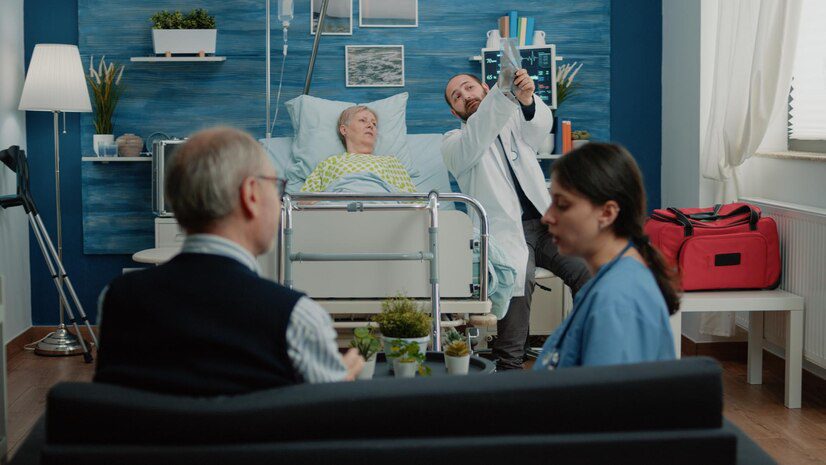Enhancing Cancer Care Journey with Innovative Home Health Care

We have now become avid readers of the ground-breaking technological developments and practical tools in radiation oncology that have entered homes and altered the premise of medical care delivery.
As per Health Tech World, the at-home diagnostic testing and equipment adaptation is projected to grow significantly, with an expected compound annual growth rate of 6.1% to 11.3% over the next five years.
These advancements are not only making care more accessible but are also empowering patients to manage their health with greater autonomy. By becoming familiar with the essential equipment for supporting cancer patients, caregivers can more effectively contribute to the patient’s care journey. We have enlisted all the latest innovative equipment and technology for enhanced cancer care at home for you to invest in. Read on and make this difficult journey of your loved one easier!
Telemedicine and Telehealth Platforms
Telemedicine platforms allow cancer patients to consult oncologists and specialists remotely, reducing the need for frequent hospital visits. It facilitates real-time communication for symptom management, treatment guidance, and follow-ups. On the other hand, telehealth platforms enable continuous monitoring of vital signs, symptoms, and treatment side effects using wearable devices. Data is transmitted to healthcare providers, who can intervene early if necessary.
Wearable Health Devices
As discussed earlier, wearable devices used by telehealth platforms that monitor vital signs have become paramount in radiation oncology. Devices like smartwatches and biosensors monitor vital signs such as heart rate, temperature, and oxygen levels, providing real-time data to healthcare providers. These devices remind patients to take medications, track their activity levels, and monitor physical conditions, improving adherence to prescribed treatments.
Mobile Health (mHealth) Apps
mHealth apps like Cancer Care, My Cancer Coach, NantHealth’s Eviti, etc., allow patients to log symptoms, medication intake, and side effects, which can be shared with healthcare providers for more accurate and timely adjustments to treatment plans. These apps offer educational resources about cancer treatments, side effects, and self-care practices, empowering patients and their senior home care providers with the knowledge to manage their condition effectively.
Virtual Reality (VR) and Augmented Reality (AR)
Cancer does not alone affect one’s physical state but also takes a toll on the mental state of a person. To fight this, VR and AR can be used for distraction therapy, helping patients manage pain and anxiety during treatments for cancer care at home by immersing them in calming environments. These technologies are used to guide patients through exercises, improving mobility and strength in a controlled, engaging manner. For instance, VR Headset and Mindmaze are two VR technologies that transport the patient into a calming state using specific radio frequencies and claiming visuals.
Home Infusion Therapy (Chemotherapy at Home)
Advances in home health care technology have allowed patients to receive chemotherapy and other intravenous treatments in the comfort of their homes under the supervision of trained nurses, reducing hospital stays. For this, medications such as Erlotinib are given orally. Next, portable infusion pumps like KORU Medical Systems’ Freedom60 are deployed to ensure precise medication delivery and include smart features for monitoring infusion parameters, improving safety and convenience for home chemotherapy.
Mobility Aids
Cancer can cripple your loved ones and cause weakness, owing to which they experience mobility challenges. However, there are multiple types of equipment in the market that help with mobility issues, helping patients live independently. These cancer care mobility aids include,
- Walking Sticks: Walking sticks offer essential support for balance and stability, especially for patients recovering from surgery or those with weakened muscles. It’s vital to ensure that the walking stick is the correct height and tailored for either left or right-handed use.
- Walking Frames (Zimmer Frames): For patients needing more substantial support, walking frames provide enhanced stability. Available with or without wheels and often equipped with seats, trays, or baskets, these frames are particularly beneficial for those who need to rest frequently or carry items.
- Wheelchairs: Wheelchairs are indispensable for cancer patients with significant mobility impairments. Whether for short-term use during recovery or long-term assistance, wheelchairs allow patients to comfortably go outdoors and in public spaces.
- Mobility Scooters: Mobility scooters provide an effective solution for covering longer distances, especially for patients with limited stamina. These scooters are designed to be road—and pavement-compatible and can be folded for transportation.
By incorporating the appropriate mobility aids to home health care, cancer patients can maintain a higher degree of independence, reduce the risk of falls, and manage their daily activities with greater ease and confidence.
Breathing Equipment
For cancer patients experiencing breathing difficulties, appropriate respiratory support is crucial for maintaining quality of life. In such cases, district nurses or the palliative care team can arrange for oxygen cylinders or a nebulizer to be used at home. A nebulizer converts medication into a vapor, making it easier for patients to inhale, especially during episodes of respiratory distress.
Beds and Chairs
Individuals suffering from cancer are required to spend extended periods in bed or seated; ensuring comfort and proper support, hence becomes vital to prevent complications such as pressure sores. For this, you can invest in:
- Pressure-Relieving Mattresses and Adjustable Beds:
A pressure-relieving mattress can help prevent bedsores by distributing weight more evenly. Also, an adjustable bed rest allows patients to find comfortable positions for sleeping or resting, reducing discomfort from prolonged bed rest.
- Pillows and Supports:
V-shaped pillows and extra pillows can provide targeted support, especially for relieving pressure on the back or supporting swollen arms and legs. This can significantly enhance comfort, especially for patients who need to change positions frequently.
- Specialized Chairs:
The main chair used by a patient should provide adequate support and comfort. An OT or PT can assess and recommend furniture raisers to make chairs higher and easier to use or suggest more suitable options like recliners that allow for better positioning and ease of movement. Pressure-relieving cushions can also be provided to prevent sores for patients who spend long periods seated.
It’s quite an understated fact that “the person taking care of his/her loved one does suffer more.” Well, it is true! But with the assistance of these tools, you can save time and energy and be aware of the current situation of your patient. To further ease out your task and focus on your health as well, you can ask for professional assistance from an experienced caregiver at Family Ties Home Care LLC! Call us at 805-917-6680 or click here for a free consultation!
